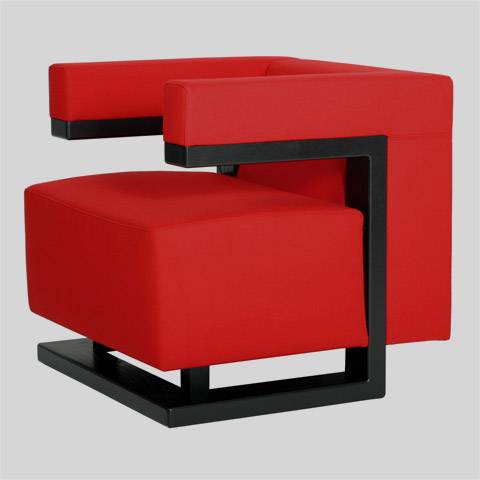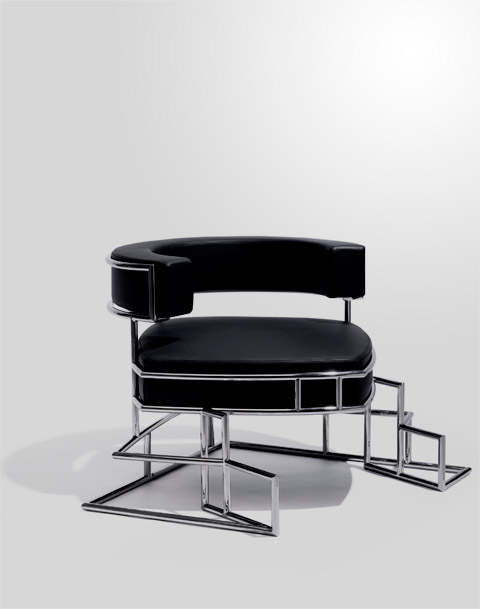They are often looked at like works of art, the so-called design classics such as Marcel Breuer's armchair "Wassily", Ludwig Mies van der Rohe's comfy chair "Barcelona", or Gerrit Rietveld's "Red Blue Chair". These items of furniture exist as pieces in their own right wherever they might stand. What is remarkable about them is that they were all designed by architects.
Who has not when looking at an empty house gone through in their minds down to the last detail asked himself what it could or should look like when furnished. Does fitting it out with furniture, fabrics and appliances underline the overall impression or does it destroy it altogether? A hundred years ago architects designed the outer shape of buildings, and carpenters the furniture, which until then was strongly bound up with traditional manufacturing methods. But with a view to ensuring the consistent impact of the entire ensemble architects gradually also began to include the interior into their designs and with their frequently unbiased view to incorporate new concepts of technology and new notions of form into product design. The result: simple furniture conceived to be economic and resource-saving. For example, Jean Prouvé's furniture items reveal influences from engineering, Carlo Mollino (a veritable generalist among the designers) invented objects at the interface between furniture and sculpture, and Gio Ponti reduced the material needed for his chair "Superleggera" to a minimum. Not to forget that architects can adopt an entirely different approach as is demonstrated by the furniture of Gae Aulenti, where the line between architecture and art seems to be blurred.
In the work of some of these architects we can identify a connection between creative experimentation and an early cardboard model of architecture and furniture design. In Frank O. Gehry's cardboard chairs the design process from which they originated is there for all to see, and the furniture by Daniel Libeskind and Zaha Hadid also reveals a distinct signature style. But when Peter Zumthor conceives a lounger for the thermal baths he designed in Vals, which is particularly delicate so as not to ruin the building's overall impression, we might ask: Is the furniture an equally valid part of a larger art work or does it subordinate itself in order not to steal the show from the ultimate discipline, namely architecture?
One thing is for sure: The scope of furniture dreamed up by architects is broad, as are the design processes in question. For all the diversity it still fascinating to ask whether and in what aspects furniture by industrial designer differs from that devised by the architects? Is it possible to detect something typically architectural in the latter? Do architects have less feeling for material? Doubtless, many designers have also at least trained as architects. As generalists who only design furniture now and then, architects who only work occasionally as designers are less subject to the restrictions of conventional design methods and techniques. And since they are dealing with the furnishing of their own architecture they can abstract from more extensive product requirements – which often results in one-offs and extraordinary objects.
The exhibition "Von Aalto bis Zumthor: Architektenmöbel" in the makk, the Cologne Museum of Applied Art, devotes itself to the furniture design of internationally acclaimed architects from the last hundred years. The exhibition makers were eager to only show those designers whose major professional activity was architecture. They include such past greats of the world of architecture as Marcel Breuer, Egon Eiermann and Mies van der Rohe, but also contemporaries like Norman Foster, Jacques Herzog and Pierre de Meuron or Jean Nouvel. Though the main focus is on the chair a few examples of entire interiors are also on show.
The exhibition „Von Aalto bis Zumthor: Architektenmöbel" in the makk is sponsored by Stylepark.
From Aalto to Zumthor: Furniture by architects
From 16 January to 22 April, 2012
Cologne Museum of Applied
www.makk.de
 Bowl “Acrylic Bowl” by Zaha Hadid, 2007, Sawaya & Moroni, Milan, photo © Sawaya & Moroni
Bowl “Acrylic Bowl” by Zaha Hadid, 2007, Sawaya & Moroni, Milan, photo © Sawaya & Moroni
 High-backed chair by Marc Held, 1965-67, Knoll, New York, photo © RBA Köln
High-backed chair by Marc Held, 1965-67, Knoll, New York, photo © RBA Köln
 Armchair “F 51”, by Walter Gropius, 1920, Tecta, Lauenförde, photo © Tecta
Armchair “F 51”, by Walter Gropius, 1920, Tecta, Lauenförde, photo © Tecta
 Table “Tour” by Gae Aulenti, 1993, Fontana Arte, Corsico, photo © Fontana Arte
Table “Tour” by Gae Aulenti, 1993, Fontana Arte, Corsico, photo © Fontana Arte
 Arm-rest chair “Torq” by Daniel Libeskind, 2010, Sawaya & Moroni, Milan, photo © Sawaya & Moroni
Arm-rest chair “Torq” by Daniel Libeskind, 2010, Sawaya & Moroni, Milan, photo © Sawaya & Moroni
 Desk with chair by Frank Lloyd Wright, about 1904, designed for the Larkin Company Office, Buffalo, New York, photo © Sascha Fuis Fotografie, Köln
Desk with chair by Frank Lloyd Wright, about 1904, designed for the Larkin Company Office, Buffalo, New York, photo © Sascha Fuis Fotografie, Köln
 Armchair “Spirit House Chair“ by Daniel Libeskind, 2007, Nienkämper, Toronto, photo © Brian Doyle
Armchair “Spirit House Chair“ by Daniel Libeskind, 2007, Nienkämper, Toronto, photo © Brian Doyle









